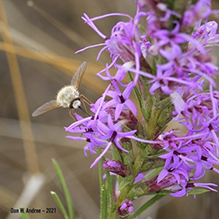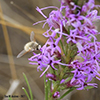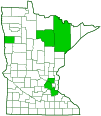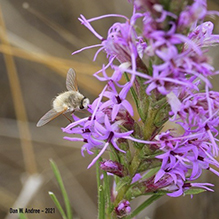bearded bee fly
(Anastoechus barbatus)
Conservation • Description • Habitat • Ecology • Distribution • Taxonomy
|
|
||||||||||||||
Description |
Bearded bee fly is a small to medium-sized, stout-bodied, bee fly. It occurs throughout the United States and southern Canada but is most common in the southwest. It is uncommon in Minnesota. Larvae are parasitic on the eggs and larvae of grasshoppers. Adults are found in fields. They feed on the pollen and nectar of dotted blazing star and white heath aster. Adults are 3⁄16″ to ⅝″ (5 to 15 mm) in length. The head and body are densely covered with long, erect, grayish-yellow hairs. The body is curved when viewed from the side. The head and the first segment of the thorax are directed downward. The head is broad. The face is densely hairy, including a dense white beard, yellowish hairs around the base of the antennae, and a tuft of long black hairs on each side along the eyes. The antennae are black and have three segments. The third segment is not divided by rings (annulated). The beak-like projection of mouthparts (proboscis) is very long. The hairs on the underside of the thorax, corresponding to the chest, are white. The hairs on the abdomen are mostly yellowish, but there is a row of long black hairs at the rear margin of each abdominal segment. This is especially evident on the male, where the black hairs give a blackish tint to the end of the abdomen. On the female they are less evident and are usually completely absent. The small, knob-like structures on each side of the thorax (halteres) are white or pale yellow, at least at the top. The wings are clear and may have a brownish tint at the base, especially on the male. The veins are yellowish-brown. The discal cell is present. The radial-media (r-m) cross vein is near the base of the discal cell. The vein that closes the discal cell is longer than the r-m cross vein. The M1 vein ends before the wing tip so that there are only three posterior cells. Cells R and M are about equal in length. The anal cell is open near the margin. The legs are long, slender, and mostly reddish-yellow. The third segment (femur) for most of its length is black but densely covered with white scales. The last part of the leg (tarsus), corresponding to the foot, has three segments. |
Size |
3⁄16″ to ⅝″ (5 to 15 mm) |
Similar Species |
Habitat |
Fields |
Ecology |
Season |
Mid-August through September (CCESR) |
Behavior |
Adults are active during the day. They do not bite. They frequently rest in open areas on bare ground, rocks, wood fragments, and leaves. The wings are held outspread when at rest. |
Life Cycle |
The female hovers over the nest of its prey. Larva undergo hypermetamorphosis, where the stages (instars) differ markedly in appearance and behavior. The first instar larva is active and penetrates the nest of its prey. It then molts and becomes a sedentary parasite. The pupa has spines with which it drills out of the nest. |
Larva Food |
Eggs and larvae of grasshoppers |
Adult Food |
Pollen and nectar of dotted blazing star and white heath aster |
Distribution |
||
|
Sources Painter, R. H. (1962). The Taxonomy and Biology of Systoechus and Anastoechus Bombyliid (Diptera) Predators in Grasshopper Egg Pods. Journal of the Kansas Entomological Society, 35(2), 255–269. http://www.jstor.org/stable/25083257 |
|
| 5/23/2024 | ||
Occurrence |
||
Uncommon |
||
Taxonomy |
|
Order |
|
Suborder |
Brachycera |
Infraorder |
Orthorrhapha |
Superfamily |
Asiloidea |
Family |
Bombyliidae (bee flies) |
Subfamily |
Bombyliinae |
Tribe |
Bombyliini |
Genus |
Anastoechus |
Subordinate Taxa |
|
|
|
Synonyms |
|
|
|
Common Names |
|
bearded bee fly |
|
Glossary
Femur
On insects and arachnids, the third, largest, most robust segment of the leg, coming immediately before the tibia. On humans, the thigh bone.
Halteres
In flies: a pair of knob-like structures on the thorax representing hind wings that are used for balance.
Instar
The developmental stage of arthropods between each molt; in insects, the developmental stage of the larvae or nymph.
Visitor Photos |
||
Share your photo of this insect. |
||
This button not working for you? |
||
Brooke Kujawa |
||
 |
||
Happened upon your site while doing a google image search for this insect I had never seen before. |
||
Dan W. Andree |
||
 |
||
I seen it at Frenchman’s Bluff SNA in August 2021. First time I noticed one. |
||
MinnesotaSeasons.com Photos |
||
|
||
|
||

Slideshows |
|

Visitor Videos |
||
Share your video of this insect. |
||
This button not working for you? |
||
|
Other Videos |
||
|

Visitor Sightings |
||
Report a sighting of this insect. |
||
This button not working for you? |
||
MJ |
Location: Austin MN Hovering about me very large stinger. |
|
Karen |
Location: Royalton Was flying around on our deck. Says is uncommon in mn? |
|
John valo |
Based om the number of records available at Global Biodiversity Information Facility (GBIF), Discover Life, BugGuide, and iNaturalist, this species is widespread across North America, but it is uncommon throughout its range, including in Minnesota. |
|
| Brooke Kujawa 8/26/2024 |
Location: 9901 Scott Ave N, Brooklyn Park, MN 55443 Happened upon your site while doing a google image search for this insect I had never seen before. |
 |
Gina Johnson |
Location: 44900 Government Rd., Harris, MN 55032 Spotted on my azalea at 10:45am |
|
| Dan W. Andree August 2021 |
Location: Frenchman’s Bluff SNA I seen it at Frenchman’s Bluff SNA in August 2021. First time I noticed one. |
 |
MinnesotaSeasons.com Sightings |
||
|

Created: 10/29/2021 Last Updated: © MinnesotaSeasons.com. All rights reserved. |


